







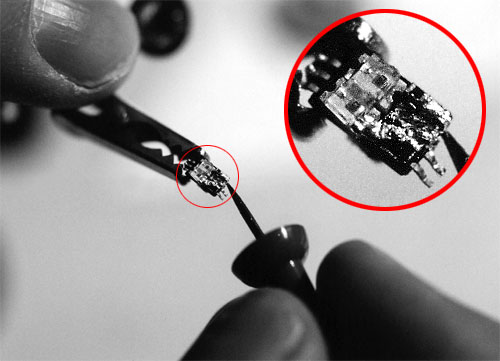

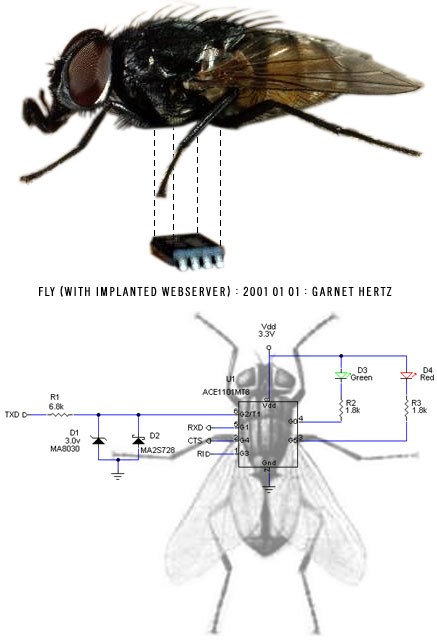
| PROJECT : TITLE | FLY |
| PROJECT : SUMMARY | One dead fly with one microprocessor implanted into the fly body. The chip is a fully operational web server on the internet, and enables online viewers to enter and exit the fly corpse. |
| PROJECT : PHYSICAL INSTALLATION OVERVIEW | One fly is placed in the center of a large physical space. This can be presented in a few different formats, although a primary conceptual and visual consideration in this work is the sense of physical scale. Therefore, the larger the space this piece is installed in, the better. (However, at a certain point, a large space would be meaningless: 5,000+ square feet would be too large for this piece in its current format). Standard blue network cabling for the fly comes from a nearby ethernet jack (RJ45) mounted on a wall, and continues directly to the fly and into its body. The installation space is ideally dark, silent, a little cold, and damp/concrete-smelling. White spotlights are focused on the fly object. The fly server is placed in the relative center of its environment. |
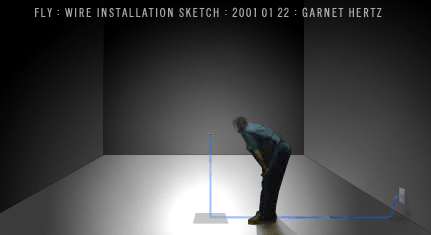
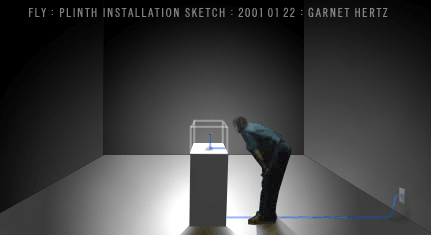
| DETAIL : FLY | The fly is a standard, large housefly. The server chip is implanted via the underside of the body, with 3 thin wires exiting the underside of the fly. These wires can act as a support for the fly, and hold it mid-air in the installation space. |
| DETAIL : WEB CONTENT | Upon visiting the server chip, the online user automatically activates a blink in one of the LEDs. When at the website content within the chip inside of the fly body, the website user has a facility to turn the user controlled LED on and off. |
| DETAIL : LEDs | The web server chip is connected to two Light Emitting Diodes ("LEDs"). Both LEDs are green (this detail may be modified before installation date). One light is triggered when an individual accesses the webserver (the "hit" LED), and another light is triggered by choice of the visitor to the website (the "user controlled" LED). The position of the LEDs within/on the fly body are to be finalized, although the hit LED will likely be inserted into the fly body, and the user controlled LED will likely be implanted into the head. |
| DETAIL : WEBCAM | A webcam is installed in the installation space with a macro view of the fly. |
| VIEWERS : DIGITAL (PARTICIPANTS) | The server chip (a "ACE1101VMT8") will have a simple webpage on it that viewers will see when visiting each part of the fly. The exact content on each server is to be determined, although each will include a hit counter and a method to contract the user-controlled LED within the fly. A non-ACE1101VMT8 ("external") website will include some general documentation about the project, the webcam images, and selected texts. |
| VIEWERS : PHYSICAL | The physical viewer of the work will see the fly in the center of the space, and sporadic blinks of light being emitted from the LEDs integrated into the fly. Some cues will be given to the website address of the fly and the nature of the activity occurring (likely via title card). |

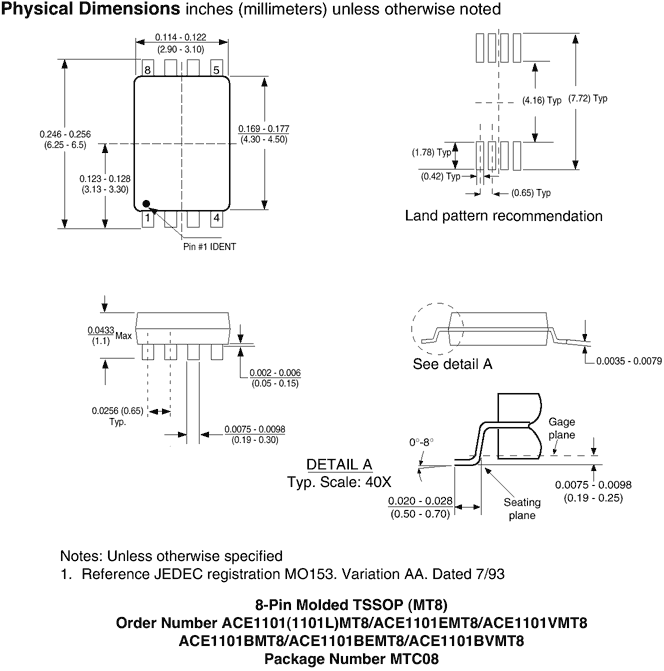
| TECHNICAL : SERVERS | Each web server is a Fairchild ACE1101VMT8 microprocessor - the current world record holder for the smallest chip that is capable of running a complete internet web server. The ACE1101 series of processors has physical dimensions of 6.3mm long by 3mm wide by 1.1mm thick. Use of these chips as webservers is virtually unprecedented - only a handful have been known to exist, and apparently only one is currently online (by the author of the original server software assembly code). Furthermore, this technology has not previously been used in a critical / conceptual context. |
| TECHNICAL : CONNECTIVITY | The ACE1101 servers run an assembly-code program called "WebACE" - which is a 1K program that includes all website material, networking, and the ability for website viewers to remotely trigger electrical switches (like LEDs, for example). The ACE1101 connects via RS232 serial port to a host computer via standard SLIP link - similar to how many computers connect to the internet via a dialup ISP. |
| TECHNICAL : PROGRAMMING LANGUAGE | The ACE1101VMT8 website content is programmed in ACE1101 assembly code. |
| TECHNICAL : POSSIBLE CHALLENGES | The main technical problem with the use of dead flies are their fragility. Implanting the chip into the body must be done within 24 hours of the fly being killed: this allows for the legs to be moved and positioned into a desirable pose. After the chip is inserted and the fly joints age, the fly legs are especially fragile and break off very easily. However, these legs can be rejoined with a dab of Krazy Glue - although finding the dismembered legs can prove to be difficult. |

| INSTALLATION : TECHNICAL REQUIREMENTS | An internet connection (any speed) with 2 static IP addresses is required. |
| INSTALLATION : PHYSICAL PREFERENCES (IDEAL) | At least 200 square feet with no windows or pillars. Preference given to an enclosed/private space. Control over ambient light levels to create a dark space is needed. Ceiling should be at least 12 feet high, and the space should have an adjacent (non-gallery) space in which cabling can be terminated and networking can be configured to the internet. A RJ45 jack (a standard ethernet cable receptacle) needs to be installed on the wall between this adjacent non-gallery space and the gallery wall. |
| INSTALLATION : PHYSICAL PREFERENCES (SUFFICIENT) | A semi-enclosed/private space, with the ability to darken the region around the fly. This is required to make the LED activity visible. The space should have an adjacent (non-gallery) space in which cabling can be terminated and networking can be configured to the internet. |
| INSTALLATION : OPTIONS | The primary concepts in this installation are the sense of scale between the fly and the surrounding area, and the ability for the LEDs to be visible. Although not preferred, the fly could be installed onto a large, empty wall. |
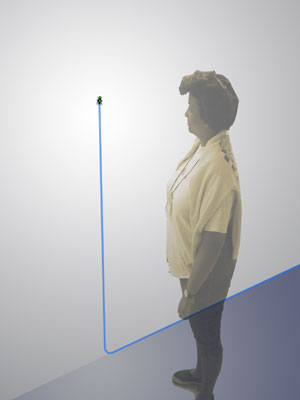
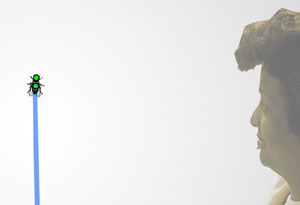
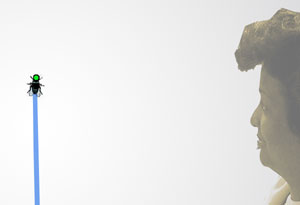
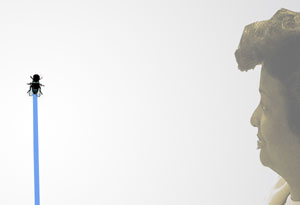
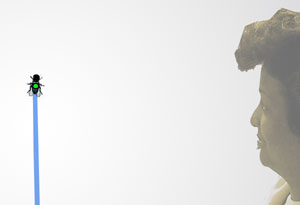
| MAINTENANCE | Several pre-programmed and wired flies will be on hand in case of technical malfunction. Each fly will be cabled with a standardized electrical male/female plug end - an RJ45 (standard ethernet) connector. This will ideally allow for gallery staff to replace the fly. |
| CONCEPTUAL : PRIMARY THEMES | Telepresence, visualization of network activity, technology and communication processes. |
| CONCEPTUAL : SECONDARY THEMES | Technology and miniaturization, cybernetics, agency, bioengineering, life, robotics. |
| CONCEPTUAL : BACKGROUND CONTEXTS | Marcel-lì Antunez Roca (Epizoo), Stelarc (Ping Body), Eduardo Kac, Rafael Lozano-Hemmer. |
| COMPLETION DATE | 2001 FEB 28 |